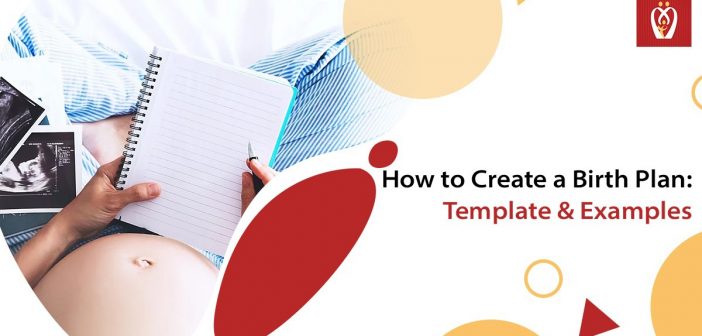It’s important to think about your preferences for labour and delivery as you move closer to meeting your kid for the first time. Some expecting mothers draught birth plans to organise their ideas and serve as a starting point for a conversation with their healthcare practitioner.
Despite the fact that pregnancy, labour, and delivery are all unexpected, communicating your preferences with everyone involved may help you feel more secure and in charge. Continue reading to learn how to write a birth plan, and what to do after it’s completed.
What is the definition of a birth plan?
A birth plan is exactly what it sounds like: a written document that outlines your wants and objectives for labour and delivery before, during, and after the event. Parents-to-be may share their ideal birthing scenario, or how they’d want labour and delivery to happen if all goes according to “plan.”
A birth plan considers what’s realistic, practicable, and what your practitioner, hospital, or birthing facility has available or will accommodate, in addition to your preferences (not everything on your birth plan may fly with them).
Template for a birth plan
There is no one-size-fits-all approach to writing a birth plan. Some papers are brief and to the point, while others are lengthy and in-depth. Because each expecting mother is unique — not just in what she wants out of the delivery experience, but also in what she may anticipate based on her pregnancy profile and history — a birth plan should be tailored to her specific needs.
Here’s a template to help you create a customised strategy. Make sure to include your and your partner’s names, as well as the names of your doctor and hospital, at the top of the page.
Basic information
- Name
- The name of the individual who is helping me is
- Birthing center/hospital
- Date of submission/induction
- Name of the practitioner
- Prior to giving birth
- My health factors include the following:
- My anticipated delivery date is
- My delivery team consists of
During the course of labour
I’d want to if medically possible:
- If my doctor permits it, I will eat and drink throughout birth.
- During labour, get out of bed and stroll around or sit up.
Labor in water
- Play music, lower the lights, burn incense, and light fragrant candles.
- Make a snapshot or video with your companion.
- Use an exercise ball, a shower in your room, or a birthing pool to help you labour.
- Make use of certain birth positions.
- Other
Medical assistance:
I would prefer (circle all that apply)
- Membrane rupture that has been induced artificially
- Maintain the integrity of the membranes for as long as feasible
- Electronic foetal monitoring, both external and internal
- Fetal monitoring on a regular basis
- Only foetal Doppler monitoring
- An IV, catheter, or enema may be used
- Using oxytocin to start or speed up labour contractions
- Episiotomy
- Natural tearing only
- To aid with the birth, vacuum extraction or forceps might be used.
- Other
Pain alleviation:
I’d rather (circle all that apply, or add a comment next to any you don’t want):
- Epidural
- Acupuncture
- Acupressure
- Exercising your breathing
- Massage
- Meditation
- Reflexology
- Other
Delivery:
- I’d want to do the following (circle all that apply):
- To view the infant crown, use a mirror
- Have a partner help catch the baby
- Allow suctioning by my companion.
- Allow my spouse to cut the umbilical cord
In the event of a C-section
I would like (circle all that apply, or add a note next to any you’d want to avoid) (if medically possible):
- Consciousness
- Clear curtains should be installed so that I can observe my kid emerge
- So that I can hold the infant, one arm should be free of cuffs, monitors, and IVs
- Breastfeeding should be started as soon as feasible.
Care for a newborn:
- I’d want to (circle all that apply, or add a comment next to any you don’t want to include):
- Hold the baby right after delivery to give it time to crawl from the abdomen to the breast
- Breastfeed as soon as possible
- I’d want a lactation consultant to assist me with breastfeeding
- Cord blood should be saved
- Cord blood may be donated
- Keep the placenta and bring it home with you
- Feed my baby formula
- Only breast milk is given to my infant
- Give my child a pacifier
- Bringing the infant into the room
- Allow my child to sleep in the nursery
- If the infant is a male, have him circumcised
- Vitamin K for my infant
- Treat my baby’s eyes with antibiotics.
- Other
What information should be included in a birth plan?
There are as many distinct birth plan examples as there are women who give birth, so don’t stress about coming up with the “perfect” plan for your labour and delivery. You don’t have to stick to a particular template or make the plan overly formal: you may do it your way by scribbling down a few of the problems that are most important to you and bringing them up with your practitioner at your next appointment.
Listen to what your practitioner has to say about your labour alternatives once you’ve discussed your preferences regarding your delivery experience. Update your birth plan if there are any adjustments you need to make.
Make numerous copies of your health-care provider-approved birth plan as a general guideline. This way, the nurses on your labour and delivery and postpartum teams will have access to them.
Creating a birth plan ahead of time may help you feel more prepared for labour and delivery while also giving you the opportunity to voice your preferences. Keep in mind, however, that a birth plan is a written agreement between you and your practitioner, not a legally enforceable contract.




